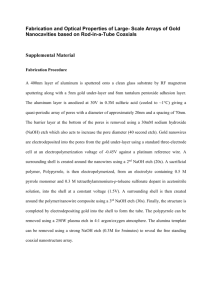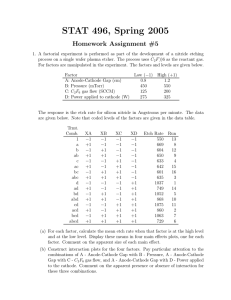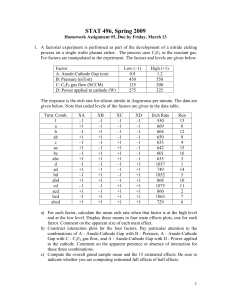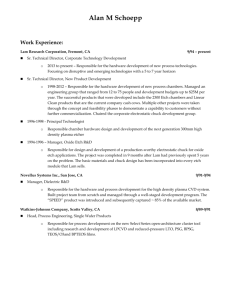2.830J / 6.780J / ESD.63J Control of Manufacturing Processes (SMA... MIT OpenCourseWare rials or our Terms of Use, visit: .
advertisement
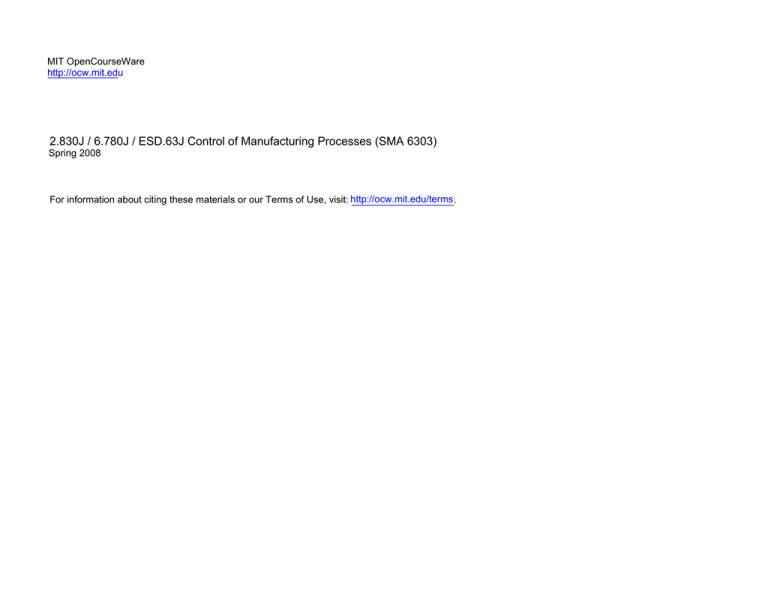
MIT OpenCourseWare http://ocw.mit.edu _____________ 2.830J / 6.780J / ESD.63J Control of Manufacturing Processes (SMA 6303) Spring 2008 s. For information about citing these materials or our Terms of Use, visit: http://ocw.mit.edu/term ___________________ Manufacturing 2.830/6.780J Control of Manufacturing Processes “An Industrial Example of Oxide Etch Process Control and Optimization” Spring 2007 Jing Yao Kai Meng Yi Qian Manufacturing Agenda • Plasma Etch Process physics • Industrial Practices – SPC Practice – A Process Improvement Experiment • Proposed DOE and RSM methods • Process control improvements and recommendations 2/1/05 2 Manufacturing Layered Wafer Manufacturing Process • 3 basic operations: – Film Deposition – Photolithography – Etch • This cycle is repeated to build up various layers in the devices. 2/1/05 Image removed due to copyright restrictions. Please see http://dot.che.gatech.edu/henderson/Introductions/Image55.gif 3 Manufacturing Types of Etching • Etch techniques – Wet etch (Isotropic) – Dry etch / Plasma etch (Anisotropic) Αnisotropy is critical in submicron feature fabrication! 2/1/05 1 Manufacturing Plasma Etching Steps • Plasma etching uses RF power to drive material removal by chemical reaction • Steps: – Formation of active gas species, e.g. CF4+ e-ÆCF3++ F+ 2e– Transport of the active species to the wafer surface – Reaction at the surface SiO2 + 4F Æ SiF4 + O2 – Pump away volatile products 2/1/05 Gas in To pump Absorption Desorbtion Reaction RF Power 5 Manufacturing Physical vs Chemical Etching Mechanism Etch Rate Selectivity Bombardmentinduced damage Anisotropy Physical Method Chemical Method Ion Bombardment Chemical Reaction Low Low High High High Low High Low • Industry often uses hybrid technique: physical method to enhance chemical etching • This gives anisotropic etch profile, reasonably good selectivity, and moderate bombardment-induced damage. 2/1/05 6 Manufacturing Plasma Etch Parameters • Gas chemistry – Fluorocarbon gases (C4F6, CF4, C4F8,etc) Atomic F is active etchant for SiO2 SiO2 + 4F Æ SiF4 + O2 Carbon reacts with oxygen to form passivation layer on Si Æ provides selectivity – O2: Under certain level, O2 scavenge C in Fluorocarbon, results in higher F concentration Æ Higher etch rate – Ar: Ar+ ion beam enhances chemical reaction 2/1/05 7 Manufacturing Plasma Etch Parameters • Pressure – Low pressure reduces ion-neutral collision on sidewalls (lateral etch), enhances anisotropic etching • Bias Power – Increase bias power enhances physical bombardment of ions • Etch Time • Temperature 2/1/05 8 Critical Issues Manufacturing • • • • • Anisotropy Selectivity Microscopic Uniformity Etch Depth Critical Dimension (CD) Image removed due to copyright restrictions. Please see http://www.memsexchange.org/catalog/P3431/file/f38826bf4266f95d6e054553/thumbnail?600 2/1/05 9 Manufacturing Background • Industry Practices in a DRAM wafer fabrication plant in Singapore • Current Technology: – 95nm 1GB DRAM on 200mm wafers – 78nm 1GB DRAM on 300mm wafers • Information source – Interview with process engineer – Scaled data based on experiments data (actual data unknown) 2/1/05 10 Focused Output Manufacturing • Etch Depth – Measuring Method • Test wafer ONLY! – Over-etch on test wafer – Cost • 5 sites measurement 100% – Percentage over-etch on test wafer • 20%-60% over-etch on test wafer • Selectivity SiO2 SiO2 150% Nitride/Silicon SiO2 Test Wafer Production Wafer • Critical Dimension – Measuring Method • Test or production wafer • 5 sites measurement Image removed due to copyright restrictions. Please see http://www.memsexchange.org/catalog/P3431/file/f38826bf4266f95d6e054553/thumbnail?600 2/1/05 11 SPC Practice Manufacturing • SPC analysis tools are installed in all production machines – X-bar chart and R chart • Different test methods for different outputs – Etch Depth • • • Insert test wafer into production lots Infrequent: ~200 hours Increase frequency when special attention needed – Critical Dimension • Test 1 wafer per lot (25 wafers) • 5 sites average 2/1/05 12 SPC Practice Manufacturing • Rules: similar to Western Electrical Handbook rules • UCL/LCL are set by process engineer – – – – Based on USL/LSL UCL/LCL are little bit tighter than USL/LSL Tighten UCL/LCL based on experience UCL/LCL are not based on standard deviation! • Process pass SPC most of the time • Stop a machine when a measurement is outside UCL/LCL, other rules mostly ignored • Slow response 2/1/05 13 Manufacturing SPC Improvement • Set UCL/LCL based on sample standard deviation • Use more effective control chart, like CUSUM or EWMA chart, to improve response time • Use multivariate process control 2/1/05 14 A Process Improvement Experiment Manufacturing • Problem – – – • Approach 1. 2. 3. 4. 5. 6. 2/1/05 Under-etch Discovered by quality assurance from finished products Process improvement is necessary because no issues found on the machine Focus on two inputs (C4F6 Flow Rate, Bias Power) Vary inputs one step away from current value Test with all inputs combinations Change third input (Time) Repeat 1 to 3 Find the best result 15 A Process Improvement Experiment Manufacturing • • 1 wafer, no replicates 5 sites average • Goal: – – CD: 100 ± 5 nm Etch Depth: 1.4 um with 60%~70% over etch on test wafer [2.25um, 2.4 um] C4F6 (sccm) C4F6 (sccm) Etch Depth (um) Etch Depth (um) Bias Power (W) 14.5 15 15.5 1300 1.72 1.68 1.56 1400 2.08 2.01 1.91 1500 2.56 2.45 2.41 Bias Power (W) 14.5 15 15.5 1300 1.63 1.60 1.50 1400 2.00 1.95 1.87 1500 2.50 2.37 2.28 190 sec 200 sec C4F6 (sccm) C4F6 (sccm) CD (nm) CD (nm) Bias Power (W) 2/1/05 14.5 15 15.5 1300 100 95 88 1400 110 103 96 1500 118 110 104 Bias Power (W) 14.5 15 15.5 1300 98 93 85 1400 106 100 94 1500 114 106 100 sccm : Standard Cubic Centimeters per Minute 16 Manufacturing A Process Improvement Experiment • A combination of DOE and OFAT – Rely on theoretical study and experience • Find an optimal based on tested input combinations • No Response Surface analysis • No replicates or center points – Hard to prove model accuracy • No variance study • Confidence Level unknown! 2/1/05 17 Experimental Design Manufacturing • Bias Power and C4F6 – Central composite design – 3 levels • Etching Time – 2 levels Factor 2/1/05 Actual test levels (coded test level) (-1) (0) (1) X1-Bias Power 1300 1400 1500 W X2-C4F6 14.5 15.0 15.5 sccm X3-Etching Time 190 200 sec 18 Run Data Manufacturing 2/1/05 Trial Bias Power C4F6 Time Etch Depth (um) Critical Dimension (nm) 1 -1 -1 1 1.72 100 2 0 -1 1 2.08 110 3 1 -1 1 2.56 118 4 -1 0 1 1.68 95 5 0 0 1 2.01 103 6 1 0 1 2.45 110 7 -1 1 1 1.56 88 8 0 1 1 1.91 96 9 1 1 1 2.41 104 10 -1 -1 -1 1.63 98 11 0 -1 -1 2.00 106 12 1 -1 -1 2.50 114 13 -1 0 -1 1.60 93 14 0 0 -1 1.95 100 15 1 0 -1 2.37 106 16 -1 1 -1 1.50 85 17 0 1 -1 1.87 94 18 1 1 -1 2.28 100 1 Time 0 -1 1 -1 Bias Power 0 0 1 -1 C4F6 Note: each run data is the mean of 5 sites average on 1 wafer 19 Manufacturing Response Models • Second order polynomial models – models built using coded variables – no transformations of output variables attempted 3 Y = b0 + ∑ bi X i + i =1 2/1/05 3 3 3 ∑ ∑b X X + ∑b X j = i +1 i =1 ij i j i =1 ii 2 i 20 Manufacturing Model Evaluation • RSM fitting – ANOVA performed – Each output model claimed significant at >99.8% confidence level or higher • Regression coefficients shown for significant terms 2/1/05 21 Etch Depth Manufacturing • Response Surface model ED = 1.970 + 0.407x1 -0.080x2 + 0.038x3 + 0.052x12 • Residual Resi dual Pl ot s f or Et ch Dept h Resid u als Versu s t h e Fit t ed Valu es 0.030 90 0.015 Residual Per cent No rmal Pro b ab ilit y Plo t o f t h e Resid u als 99 50 10 1 -0.050 0.000 Residual 0.025 0.050 1.50 4 3 0.015 2 1 0 1.75 2.00 2.25 Fit t ed Value 2.50 Resid u als Versu s t h e Ord er o f t h e Dat a 0.030 Residual Fr equency -0.015 -0.030 -0.025 Hist o g ram o f t h e Resid u als 2/1/05 0.000 0.000 -0.015 -0.030 -0.03 -0.02 -0.01 0.00 0.01 Residual 0.02 0.03 2 4 6 8 10 12 14 Obser vat ion Or der 16 18 22 Etch Depth – Contour Plot Manufacturing Cont our Pl ot of Et ch Dept h vs Ti me, Bi as Pow er Cont our Pl ot of Et ch Dept h vs C4 F6 , Bi as Pow er 1.0 Etch Depth < 1.6 1.6 - 1.8 1.8 - 2.0 2.0 - 2.2 2.2 - 2.4 > 2.4 Hold Values Time 0 0.0 -0.5 Etch Depth < 1.6 1.6 - 1.8 1.8 - 2.0 2.0 - 2.2 2.2 - 2.4 > 2.4 0.5 Time 0.5 C4F6 1.0 Hold Values C4F6 0 0.0 -0.5 -1.0 -1.0 -0.5 0.0 Bias Pow er 0.5 -1.0 -1.0 1.0 -0.5 0.0 Bias Pow er 0.5 1.0 Cont our Pl ot of Et ch Dept h vs Ti me, C4 F6 1.0 Etch Depth < 1.90 1.90 - 1.95 1.95 - 2.00 2.00 - 2.05 > 2.05 0.5 Time Hold Values Bias Power 0 0.0 • Etch Depth most sensitive to Bias Power • Bias Power , or Time , or C4F6 Etch Depth -0.5 -1.0 -1.0 2/1/05 -0.5 0.0 C4F6 0.5 1.0 23 Critical Dimension Manufacturing • Response Surface model CD = 101.111 + 7.750x1 -6.583x2 + 1.556x3 • Residual Resi dual Pl ot s f or CD No rmal Pro b ab ilit y Plo t o f t h e Resid u als Resid u als Versu s t h e Fit t ed Valu es 99 1 Residual Per cent 90 50 10 1 0 -1 -2 -1 0 Residual 1 2 90 Hist o g ram o f t h e Resid u als 120 1 4.5 Residual Fr equency 2/1/05 110 Resid u als Versu s t h e Ord er o f t h e Dat a 6.0 3.0 1.5 0.0 100 Fit t ed Value 0 -1 -1.5 -1.0 -0.5 0.0 Residual 0.5 1.0 2 4 6 8 10 12 14 Obser v at ion Or der 16 18 24 Critical Dimension – Contour Plot Manufacturing Cont our Pl ot of CD vs Ti me, Bi as Pow er Cont our Pl ot of CD vs C4 F6 , Bi as Pow er CD < 90 95 100 105 110 > C4F6 0.5 1.0 90 95 100 105 110 115 115 Hold Values Time 0 0.0 95 100 105 110 110 Hold Values C4F6 0 0.0 -0.5 -0.5 -1.0 -1.0 CD < 95 100 105 > 0.5 Time 1.0 -0.5 0.0 Bias Pow er 0.5 -1.0 -1.0 1.0 -0.5 0.0 Bias Pow er 0.5 1.0 Cont our Pl ot of CD v s Ti me, C4 F6 1.0 CD < 95.0 97.5 100.0 102.5 105.0 > Time 0.5 Hold Values Bias Power 0 0.0 -0.5 -1.0 -1.0 2/1/05 95.0 97.5 100.0 102.5 105.0 107.5 107.5 -0.5 0.0 C4F6 0.5 • CD most sensitive to Bias Power & C4F6 • Bias Power , or Time , or C4F6 CD 1.0 25 Process Optimization Manufacturing • Optimization criteria for Oxide etch and the best values attainable within the resulting optimized factor space Factor Optimization Criteria Best Values 2.25 μ m ≤ CD ≤ 2.40 μ m Etch Depth Critical Dimention 100 ± 5nm 2.25 μ m 100 nm • Optimal Input 2/1/05 X1-Bias Power X2-C4F6 X3-Etching Time Model 1487 W 15.48 sccm 190 sec Actual 1500 W 15.5 sccm 190 sec 26 23 Full Factorial Design Manufacturing • Only consider linear relationships • Drop other 10 test points (possible test points for lack-of-fit) 1 Time 0 1 -1 -1 2/1/05 0 0 Bias Power 1 Etch Depth (um) 1.72 Critical Dimension (nm) 100 -1 1 2.56 118 -1 1 1 1.56 88 4 1 1 1 2.41 104 5 -1 -1 -1 1.63 98 6 1 -1 -1 2.50 114 7 -1 1 -1 1.50 85 8 1 1 -1 2.28 100 Trial Bias Power C4F6 Time 1 -1 -1 2 1 3 1 C4F6 -1 27 Etch Depth Manufacturing • Predicted Value (p<0.01) ED = 2.020 + 0.418x1 -0.083x2 + 0.043x3 • Residual Residual Plots for Etch Depth Normal Probability Plot of the Residuals Residuals Versus the Fitted Values 99 0.02 Residual Percent 90 50 10 1 -0.050 -0.025 0.000 Residual 0.025 Histogram of the Residuals 1.50 1.75 2.00 2.25 Fitted Value 2.50 Residuals Versus the Order of the Data 0.02 1.5 Residual Frequency 2/1/05 -0.02 -0.04 0.050 2.0 1.0 0.5 0.0 0.00 -0.03 -0.02 -0.01 0.00 Residual 0.01 0.02 0.00 -0.02 -0.04 1 2 3 4 5 6 Observation Order 7 8 28 Critical Dimension Manufacturing • Predicted Value (p<0.01) CD = 100.875 + 8.125 x1 -6.625x2 + 1.625x3 • Residual Residual Plots for CD Residuals Versus the Fitted Values 1.0 90 0.5 Residual Percent Normal Probability Plot of the Residuals 99 50 10 1 0 Residual 1 80 2.0 1.0 1.5 0.5 1.0 0.5 0.0 90 100 Fitted Value 110 120 Residuals Versus the Order of the Data Residual Frequency -0.5 -1.0 -1 Histogram of the Residuals 0.0 -0.5 -1.0 -1.00 -0.75 -0.50 -0.25 0.00 Residual 2/1/05 0.0 0.25 0.50 0.75 1 2 3 4 5 6 Observation Order 7 8 29 DOE Improvement Manufacturing • Adding replicates at center points – Use to assess pure error (‘noise’) as percentage of the response – Assess lack of fit • Use Factorial Design – – – Current practice 18 trails 23 with 4 center points 12 trails 33-1III with 6 center points 15 trails • Analyze Variation – consider variation at the desired value • Randomize run order – Esp. in replicates to minimize the trend 2/1/05 30 Manufacturing Process Control Recommendations • SPC Analysis – Use more effective control chart, like CUSUM or EWMA chart – Use multivariate process control • DOE and RSM optimization – Adding replicates at center points – Use Factorial Design – Analyze Variation – Randomize run order 2/1/05 31 Manufacturing Thank You! 2/1/05 32

